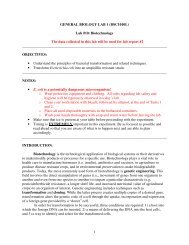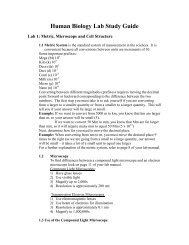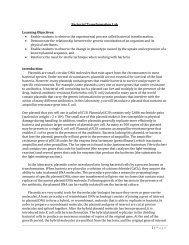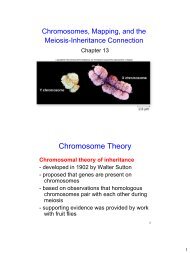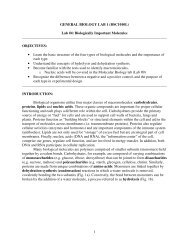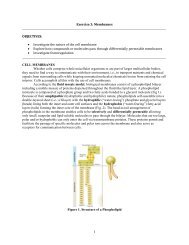Chapter 17. The origins of life and Precambrian evolution
Chapter 17. The origins of life and Precambrian evolution
Chapter 17. The origins of life and Precambrian evolution
You also want an ePaper? Increase the reach of your titles
YUMPU automatically turns print PDFs into web optimized ePapers that Google loves.
EVOLUTION/LECTURE1<br />
rRNA, appears in Figure 14.16.<br />
Figure 14.16.: An estimate <strong>of</strong> the phylogeny <strong>of</strong> all living organisms.<br />
This tree is based on the analysis <strong>of</strong> nucleotide sequences <strong>of</strong><br />
small-subunit rRNAs<br />
<strong>The</strong> whole-<strong>life</strong> rRNA phylogeny has prompted a dramatic revision <strong>of</strong> our traditional view<br />
<strong>of</strong> the organization <strong>of</strong> <strong>life</strong>, because it reveals that the five-kingdom system <strong>of</strong><br />
classification [i.e., Plants, Animals, Fungi, Protists (this is the taxomic kingdom that<br />
comprises a variety <strong>of</strong> unicellular <strong>and</strong> some simple multinuclear <strong>and</strong> multicellular<br />
eukaryotic organisms, they include some algae, the protozoans, <strong>and</strong> multicellular<br />
or multinucleate autotrophs), <strong>and</strong> Monera (this is taxonomic kingdom that comprises<br />
the prokaryotes (bacteria <strong>and</strong> cyanobacteria))] bears only a limited resemblance to actual<br />
<strong>evolution</strong>ary relationships.<br />
11.4.- <strong>The</strong> prokaryotes, for example, which are all grouped in the kingdom Monera in<br />
the traditional classification, occupy two <strong>of</strong> the three main branches <strong>of</strong> the rRNA<br />
phylogeny. One <strong>of</strong> these two branches, the Bacteria, includes virtually all <strong>of</strong> the wellknown<br />
prokaryotes. <strong>The</strong> other prokaryote branch, the Archaea, is not well known.<br />
Many <strong>of</strong> the Archaea live in physiologically harsh environments like hot springs, <strong>and</strong> are<br />
difficult to grow in culture. <strong>The</strong>y are also known as the Archebacteria<br />
11.5.- As the phylogeny in Figure 14.16 shows, the archebacteria are in fact more closely<br />
related to the eukaryotes than they are to the true bacteria. <strong>The</strong> most inclusive taxonomic<br />
units in the new classification are three domains corresponding to the three main branches<br />
file:///E|/CH17-PRECAMBRIAN-SPRING-2008/CHAPTER%2017_SPR_2008.HTML[12/8/2011 2:57:27 PM]








